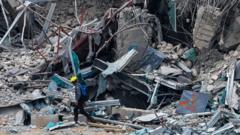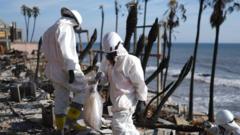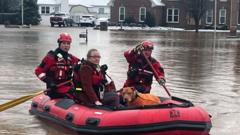Earthquake forecasters like Brent Dmitruk gain attention with their predictions, yet scientists maintain these forecasts lack accuracy. Seismologists explain the unpredictability of earthquakes and highlight the importance of preparedness through drills and warning systems.
The Myth of Earthquake Predictions: Understanding Their Unreliability

The Myth of Earthquake Predictions: Understanding Their Unreliability
Despite social media claims of earthquake predictions, experts emphasize the unpredictability of seismic events, urging preparedness over forecasts.
In mid-October, Brent Dmitruk, known to his followers as an earthquake predictor, announced on social media that a significant earthquake was imminent near California’s coast, south of Eureka. Just two months later, a 7.3 magnitude quake indeed occurred in that very area, leading many to flock to Dmitruk for future predictions. He argues that there’s talent involved in anticipating such events, claiming, “it requires serious skill to figure out where earthquakes will go.”
However, scientists studying seismic activity assert a different narrative: earthquakes cannot be reliably predicted. Seismologist Lucy Jones, a veteran of the US Geological Survey, has dedicated her research towards understanding earthquake probabilities and strengthening community resilience. Jones emphasizes the human tendency to seek patterns amid fear: “It’s a very normal human response to being afraid… but it does not have any predictive power.”
Globally, over 100,000 earthquakes occur annually, making it natural for individuals to desire foresight. The Eureka region, where Dmitruk's forecast came true, is classified as one of the most seismically active zones in the US. According to the USGS, this area is part of the Mendocino Triple Junction, where three tectonic plates converge, creating stress that can lead to earthquakes. Given the area’s history of seismic events, selecting it as a prediction target is more a gamble with better odds than a skillful insight.
Though the prediction turned out correct, Jones points out that earthquakes and their magnitude result from a complex interplay of geological dynamics, complicating any attempts to accurately forecast such events. While scientists can estimate probabilities of earthquake occurrences in specific regions over a set timeframe, precise predictions remain elusive.
Significant earthquakes, dubbed “the big one,” happen with a defined frequency, with the Cascadia subduction zone generating massive tsunamis every 300-500 years. Meanwhile, the San Andreas fault produces its own potentially devastating quakes every 200-300 years. While these geological records suggest regularity, the unpredictable nature of earthquakes persists.
Dmitruk, lacking a scientific background, continues to posit future catastrophic quakes, including a hypothetical 10.3 magnitude event expected to disrupt global trade. He often adjusts his timelines, forecasting major earthquakes around the inauguration of officials or set dates. Jones humorously acknowledges the random nature of such predictions: “When you get a prediction every week, somebody’s going to be lucky.”
Experts underscore that validated predictions require specific elements—a date, time, location, and magnitude—yet Dmitruk's predictions modify frequently. However, this tendency to seek reassurance through forecasts is human nature, as Jones notes, pointing out how random patterns can seem meaningful, akin to spotting constellations in the stars.
While earthquake prognostications remain unreliable, experts advise the public to focus on preparedness instead. Annually, millions of Americans partake in the Great ShakeOut, the largest earthquake drill worldwide, where participants practice safety protocols such as Drop, Cover, and Hold On. The event has extended from California to various regions and even countries with seismic risks.
Additionally, the USGS oversees the ShakeAlert system, which utilizes pressure wave detection from seismic events. Though it does not predict earthquakes far in advance, it provides crucial seconds for people to prepare when shaking starts. This represents the most sophisticated system developed so far for earthquake preparedness, underscoring the necessity for vigilance in the face of uncertainty.




















